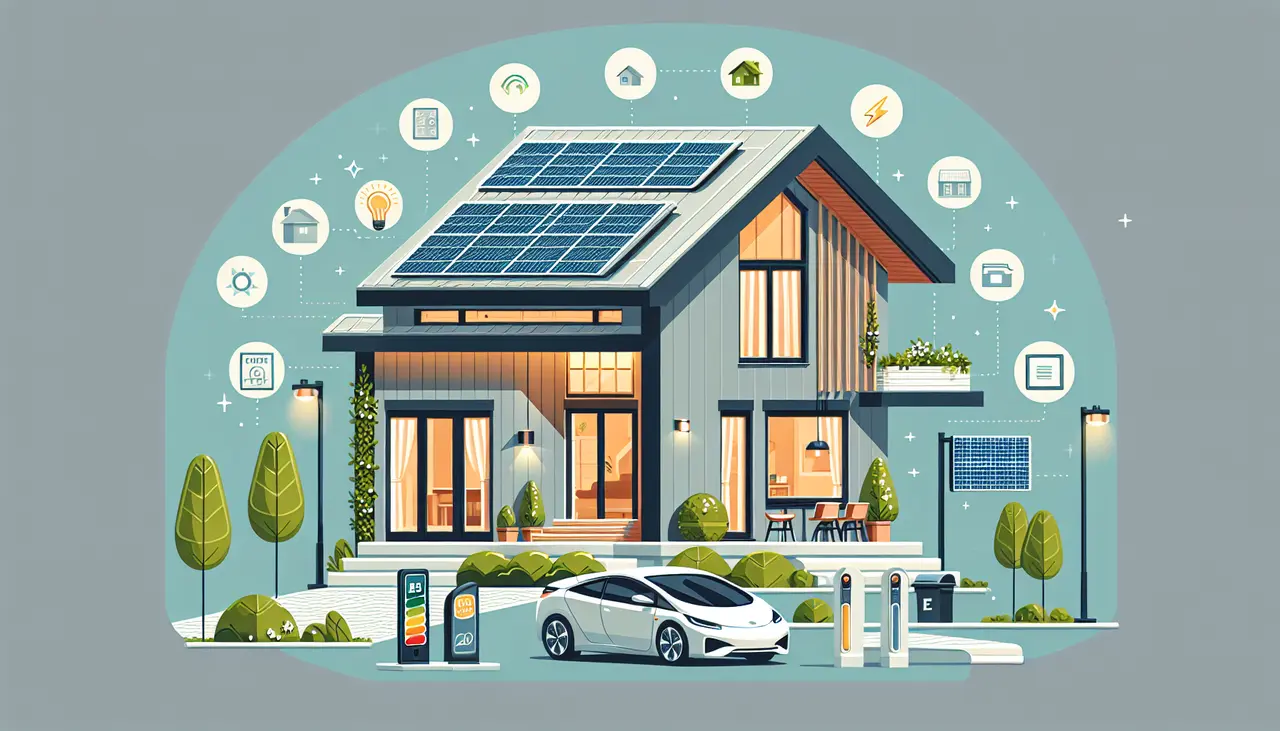Introduction to Modern Roofing and Energy Efficiency
Modern roofing isn’t just about keeping you dry or adding curb appeal to your abode. It’s a game-changer in the world of energy efficiency, directly impacting how much you pay for heating and cooling your house. Think of your roof as your home’s shield. Traditional roofs absorb heat, cranking up your AC bill during those scorching summer months. Enter modern roofing materials—cool roofs, solar tiles, and green roofs. These aren’t your grandma’s shingles. They’re designed to reflect more sunlight, emit absorbed heat more efficiently, and even harness solar energy or support plant life. This means your house can stay cooler naturally during hot spells, and your energy bills? They take a nosedive. So, when talking about modern roofs, we’re really looking at smart ways to keep your home comfortable while giving your energy bill a significant trim. It’s not just a roof; it’s a savvy investment into a more sustainable, wallet-friendly home environment.
Understanding How Modern Roofing Materials Contribute to Energy Savings
Modern roofing materials are not just about protecting your home from the rain or sun; they’re about saving you money on your energy bills too. Let’s break it down. Materials like cool roofing, metal, slate, and tiles reflect more sunlight and absorb less heat compared to traditional roofing materials. In simple terms, these materials can keep your house cooler during those hot summer days, meaning your air conditioner won’t have to work as hard. That’s a win for your wallet.
Cool roofing, for example, is designed to reflect more sunlight and absorb less heat. It’s like putting a giant sunshade over your house. Metal roofs are also great. They reflect solar radiant heat which can significantly reduce cooling costs—another easy win.
Solar tiles take it a step further by converting sunlight into electricity that can power your home. While the upfront cost may be higher, the long-term savings and environmental benefits are undeniably attractive.
In the bigger picture, using these materials can lower the temperature of your roof by up to 50 degrees Fahrenheit. This not only saves you money on energy bills but also helps in reducing the heat island effect in urban areas, making it a smart choice both for your pocket and the planet.
So, investing in modern roofing materials is not just about getting a new roof. It’s about making a smart investment that pays off in energy savings, reduced environmental impact, and potentially increasing your home’s value. Keep it simple, choose wisely, and save big.
The Role of Roof Color and Reflectivity in Cooling Your Home
Choosing the right roof color isn’t just about matching your home’s style – it’s a key player in keeping your house cool, especially in hot climates. Light-colored roofs reflect more sunlight than dark ones. This means they do less in absorbing heat, working in your favor by keeping the inside of your home cooler. Think of wearing a white shirt on a sunny day versus a black one; the same concept applies to roofs. Reflective roofs, often called cool roofs, bounce back the sunlight, helping to reduce the temperature inside your home by up to 50 degrees during peak summer. This isn’t just good for staying comfortable, it also means your air conditioning doesn’t have to work as hard, cutting down on your energy bills. So, when thinking about a new roof, remember light and bright is right for beating the heat.
Insulation Properties of Modern Roofing Systems
Modern roofing systems are a game-changer for making homes more energy-efficient. Let’s break this down simply: the main job of your roof is to keep you dry and comfortable, right? Well, roofing technology has sprinted ahead, and now, materials do more than just keep out the rain. They’re designed to keep your house cooler in summer and warmer in winter. Insulation is the hero here. Good insulation means your air conditioning and heating systems don’t have to work like mad. This translates into lower energy bills for you.
So, what’s the deal with these modern systems? They use materials that reflect sunlight and emit heat instead of absorbing it. Think of it like wearing a white shirt on a sunny day. This keeps your attic, and in turn, your entire home, cooler. Also, some roofs are now made with materials like specially designed tiles or metal roofing that provide excellent insulation. This isn’t just about keeping the heat or cold out; it’s about creating a stable temperature inside your home throughout the year.
In essence, investing in a modern roofing system can be a smart move not only for the immediate comfort but also for the long-run savings on your energy bills. It’s a win-win: you get a comfy home and do a bit of good for the planet by using less energy.
The Impact of Roof Shape and Design on Energy Efficiency
Roof shape and design play a crucial role in your home’s energy efficiency. Simple, right? But here’s how. A flat roof might seem like a modern touch, but it doesn’t shed rain or snow as well as sloped designs. Now, imagine a sloped roof; it does more than just look good. It channels water away, reducing leaks and water damage risks. But the real game-changer? The color and material of your roof. Light-colored roofing reflects the sun’s heat, keeping your house cooler in summer. Dark roofs, on the other hand, can turn your attic into an oven on hot days. Materials are key too. Metal roofs reflect heat, while asphalt shingles absorb it. So, picking the right shape, color, and material for your roof can significantly cut down heating and cooling costs. It’s not just about saving money, though. By using energy more efficiently, these design choices help reduce your home’s carbon footprint. Good for your wallet, great for the planet.
The Benefits of Installing Solar Panels on Modern Roofs
Solar panels are a game changer for energy efficiency in modern homes. Not only do they help the planet by using the sun’s power, but they also cut down on your energy bills. Here’s the deal: once you install solar panels, you can say goodbye to those sky-high electricity costs. The sun’s energy is free, so after the initial setup cost, the savings start rolling in. Plus, solar panels boost your home’s value. Buyers love energy-efficient homes. In areas with lots of sunshine, it’s a no-brainer, but even in places with less sun, you still get benefits. Moreover, governments often give tax credits or incentives for solar energy, making it an even sweeter deal. And let’s not forget, by using solar panels, you’re doing your part in fighting climate change. It’s a win-win. Energy savings, home value, tax breaks, and helping the planet? Solar panels are a smart choice for modern roofs.
How Green Roofs and Living Roofs Boost Energy Efficiency
Green roofs, also known as living roofs, are more than just a trendy eco-friendly choice for roofing; they’re a solid investment in energy efficiency for your home. Here’s how they work: by planting vegetation on your roof, you’re adding a natural layer of insulation. This doesn’t just look cool, it keeps your house cooler too. During hot summer days, a green roof can reduce the need for air conditioning by absorbing heat instead of your roof getting hot and passing that heat down into your home. In winter, the same layer that keeps your place cool in summer, helps retain heat, cutting down your heating costs. So, you save money year-round.
But there’s more. Green roofs also manage rainwater better. Instead of rain hitting your roof and immediately bouncing off, it gets absorbed by the plants and soil, reducing runoff and helping to keep your surroundings a bit drier during heavy rainfall. This can also reduce the strain on city sewage systems during storms.
In short, by choosing a green or living roof, you’re not just picking a roofing option that looks great and is kind to the planet. You’re picking an effective tool for slashing your energy bills and creating a more comfortable home environment. It’s a win-win.
The Importance of Proper Installation and Maintenance
Getting your new energy-efficient roof installed right is crucial. A sloppy job can mean all those energy-saving features might as well not exist. Think of it like this: you wouldn’t want gaps in your sweater when the cold wind blows, right? The same goes for your roof. Proper installation ensures that every bit of material works as it should, keeping your home snug and your energy bills down. Plus, maintenance can’t be overlooked. Regular check-ups catch small issues before they turn into big, costly problems. It’s like going to the doctor for a yearly check-up to make sure everything’s working fine. This way, your energy-efficient roof stays in top shape, lasting longer and saving you more money over time. Remember, an energy-saving roof is only as good as its installation and upkeep.
Comparing the Long-Term Savings of Various Modern Roofing Options
When thinking about saving energy and money in the long run, your roof plays a key role. Not all roofs are created equal. Some modern roofing options offer better insulation and reflect solar heat more efficiently, leading to noticeable savings on your energy bills. Let’s break it down simply. Traditional asphalt shingles are the go-to for many but don’t offer much in terms of energy savings. Metal roofs, on the other hand, reflect solar heat away from your home, keeping it cooler. This can save you up to 40% on your annual energy costs. Then, there’s the green or living roofs. These are covered with plants, which provide natural insulation. They’re not just good for your wallet but the environment too. Green roofs regulate temperature, cutting down on heating and cooling costs. Solar tiles are a newer player in the field. They act like regular roofing tiles but convert sunlight into electricity. Initial costs are high, but the long-term savings and the fact you’re generating your own power are huge pluses. Lastly, cool roofs are designed with special reflective materials that can lower roof surface temperature by up to 50 degrees. They’re especially effective in hot climates, leading to less dependence on air conditioning. In summary, while the upfront costs of some modern roofing options might be higher, the long-term savings make them worth considering. Metal roofs, green roofs, solar tiles, and cool roofs all offer unique benefits that can lead to significant energy and cost savings over time. Keep in mind, the best option depends on your climate, home design, and budget.
Conclusion: Maximizing Home Energy Efficiency with Modern Roofing
Choosing the right modern roofing can drastically improve your home’s energy efficiency. Materials like cool roofing, solar tiles, and green roofs don’t just protect your home from the elements; they also help slash energy bills and reduce your carbon footprint. Cool roofs reflect more sunlight and absorb less heat, solar tiles generate electricity by capturing solar energy, and green roofs insulate your home while managing stormwater. Though the initial investment might seem high, the long-term savings on energy costs and the environmental benefits make it a wise decision. Remember, every choice counts towards a more sustainable and energy-efficient home. Consider these modern roofing options to enhance your home’s energy efficiency effectively.







